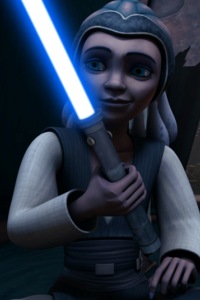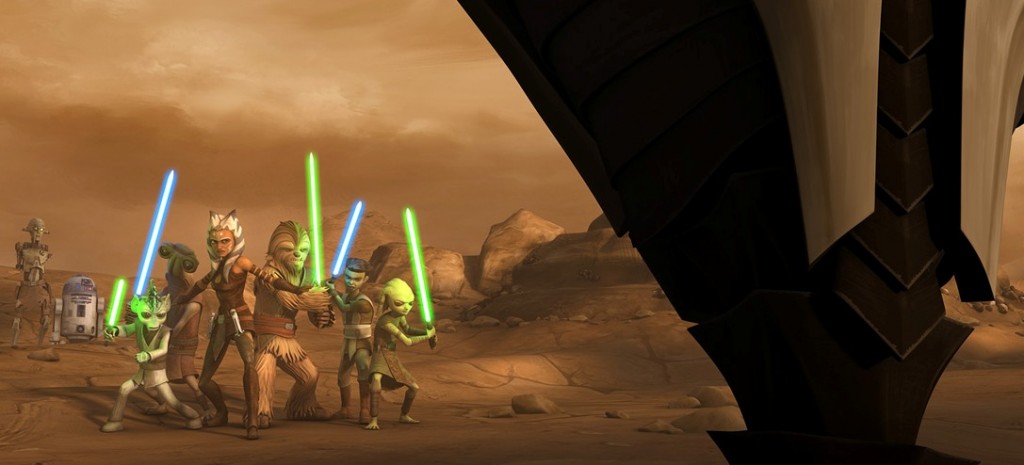The Young Jedi, Ahsoka, and a Hint of Stories to Come?
 “A Necessary Bond” brought the Young Jedi arc of The Clone Wars to an action-packed conclusion. Megan’s review hits many of my favorite moments in the episode, as well as touches on its weaknesses.
“A Necessary Bond” brought the Young Jedi arc of The Clone Wars to an action-packed conclusion. Megan’s review hits many of my favorite moments in the episode, as well as touches on its weaknesses.
Looking back over the four episodes, an arc that initially appeared to be delivering simpler stories about the Jedi younglings turned out to tell another adult tale that was really Ahsoka’s story. Approaching the midpoint of Season Five, Ahsoka’s transition from a young Padawan with much to learn into a teenaged apprentice with sometimes more discipline and maturity than her Jedi Knight mentor is well underway – and The Clone Wars is fast approaching developing Ahsoka into a character not too far removed from the eager heroes of the movies: Obi-Wan in The Phantom Menace, Anakin in Attack of the Clones, and Luke in the Original Trilogy. I’m beginning to think there was a good reason Christian Taylor, writer of the outstanding Mortis trilogy, was tapped for this arc: because Ahsoka isn’t just a great new character for The Clone Wars, but a test run for the kind of character – a strong female Jedi heroine – we could see as Sequel Trilogy’s lead protagonist.
The Young Jedi arc ended up offering much more than first impressions seemed to indicate. The first episode, “The Gathering,” used a more simplistic plot that portrayed each youngling facing down his or her biggest weakness before finding their personal lightsaber crystal. Alone, this episode did have the feel of a “backdoor pilot” for a younger-oriented series than what The Clone Wars has become, in Seasons Four and Five in particular. The third episode, “Bound for Rescue,” featured the younglings using the cover of circus acrobats to mount an operation to liberate Ahsoka from captivity by Hondo’s pirates. The rest of that story, though, involved much darker and more mature content, particularly Grievous’ brutal killing of a clonetrooper and Hondo’s unabashed willingness to ransom off Ahsoka to the highest bidder. The other two episodes, “A Test of Strength” and “A Necessary Bond,” showcased Ahsoka living up to the maturity and commitment to duty she previously demonstrated in the Onderon arc. Other characters played their parts, of course, notably Hondo filling out the Jester archetype perfectly and Katooni’s progression through a secondary heroic arc from hesitancy and self-doubt to boldly shaming Hondo into going back for the others.
Importantly, Ahsoka’s heroism in the Young Jedi arc is primarily in the role of a protector and nurturer. The heroism of Katniss Everdeen has been praised in a similar way, and the box office and book-sales success of The Hunger Games speaks for itself. Another famous strong female heroine, Buffy Summers, also acted more often as a protector than an aggressor, and later in her career she mentored numerous other Slayers.  I don’t think it’s a coincidence that Christian Taylor worked exactly this kind of dynamic into Ahsoka’s storyline in this arc, which likely was being written and produced around the time The Hunger Games’ transition to the silver screen was rapidly building momentum.
I don’t think it’s a coincidence that Christian Taylor worked exactly this kind of dynamic into Ahsoka’s storyline in this arc, which likely was being written and produced around the time The Hunger Games’ transition to the silver screen was rapidly building momentum.
Most of all, the Young Jedi arc emphasizes Ahsoka’s unwavering commitment to her primary duty on this mission – ensuring the safety and survival of the younglings. When the ship is attacked, she hurries them to safety; when the plan fails, she risks her life to expel the pirates. As Hondo’s prisoner, she refuses to beg for mercy or offer concessions, but when the balance of power shifts under the Separatist assault, she doesn’t hesitate to deal with her erstwhile captors to escape the planet. When Grievous tracks down the fleeing Jedi, Ahsoka avoids her reckless mistake from Season One of trying to defeat him herself, instead stalling him until the younglings are safely aboard Slave I before retreating to join them. Despite several opportunities, Ashoka doesn’t try to win the fight – she only does enough to carry out her duty. The online reaction to the arc has been positive, with numerous favorable reviews and nobody questioning Ahsoka’s capabilities to perform as she did. I wouldn’t be surprised if the Sequel Trilogy features another central Jedi heroine.
- Hyperspace Theories: Bad Luck Ghorman - June 2, 2025
- Hyperspace Theories: One Year Later as ANDOR Kicks Off Season Two - May 15, 2025
- REVIEW: Tales of the Underworld - May 4, 2025











